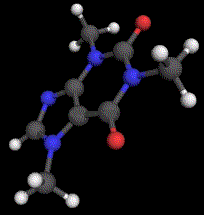Caffeine
Note: some carbon and hydrogen atoms are omitted in this type of diagram.
|
General |
|
|---|---|
| Name | Caffine |
| Chemical formula | C8H10N4O2l]] |
|
Physical |
|
| Formula weight | 36.5 amu |
| Melting point | 238 °C |
| Boiling point | 178 °C (sublimes |
Caffeine is a chemical compound found naturally in such foods as coffee beans, tea, cacao beans (chocolate), kola nuts, maté, and guarana. It is well known for its characteristic, intensely bitter taste, and as a stimulant of the central nervous system, heart, and respiration. It is also a diuretic. It is added to some soft drinks such as colas and Mountain Dew.
Chemical properties
Caffeine is an alkaloid of the methylxanthine family, which also includes the similar compounds theophylline and theobromine. In its pure state it is an intensely bitter white powder. Its chemical formula is C8H10N4O2, its systematic name is 1,3,7-trimethylxanthine or 3,7-dihydro-1,3,7-trimethyl-1H-purine-2,6-dione, and its structure is shown to the right.
Physical properties
Pure caffeine occurs as odorless, white, fleecy masses, glistening needles or powder.
BOILING POINT: 178 °C (sublimes) MELTING POINT: 238 °C SPECIFIC GRAVITY: 1.2 VOLATILITY: 0.5% VAPOR PRESSURE: 760 mm Hg @ 178 °C pH: 6.9 (1% solution) SOLUBILITY IN WATER: 2.17% VAPOR DENSITY: 6.7 MOLECULAR WEIGHT: 194.19
Sources
One dose of caffeine is generally considered to be 100 mg, delivered by one 5 fl oz / 1.5 dl cup of drip coffee or one caffeine tablet. Real-world coffee varies considerably in caffeine content per cup, from about 75 - 250 mg. Tea and cola contain somewhat less caffeine per serving than coffee, while yerba mate contains significantly more.
The amount of caffeine in some common consumables is approximately as follows:
- Chocolate, milk - 3-6 mg per ounce (100 - 210 mg per kg)
- Chocolate, bittersweet - 25 mg per ounce (875 mg per kg)
- Cocoa - 0.5 mg per ounce (17 mg per litre)
- Coffee, brewed (drip) - 4-20 mg per ounce (130 - 680 mg per litre)
- Coffee, instant - 4-12 mg per ounce (130 - 400 mg per litre)
- Coffee, decaffeinated - 0.4-0.6 mg per ounce (13 - 20 mg per litre)
- Energy drink - 10 mg per ounce (340 mg per litre). Some countries cap the caffeine content at 135 mg per litre.
- Espresso - 100 mg per ounce (3400 mg per litre)
- Soft drink (caffeinated) - 3-8 mg per ounce (100 - 270 mg per litre)
- Caffeine pills - 200 mg (100 mg in many countries within EU)
- Black tea, brewed (USA) - 2.5-11 mg per ounce (85 - 370 mg per litre)
- Black tea, brewed (other) - 3-14 mg per ounce (100 - 470 mg per litre)
- Tea, instant - 3.5 mg per ounce (120 mg per litre)
- Tea, canned iced - 2-3 mg per ounce (70 - 100 mg per litre)
- Yerba maté, cured herb - 280-425 mg per ounce
In the European Union, a warning must be placed on packaging if the caffeine content of any beverage exceeds 150 mg per litre. This includes caffeine from any source (including guarana, which is often found in energy drinks). Caffeine is in many countries classified as a flavouring.
Metabolism and toxicology
Caffeine is thought to act on the brain by blocking adenosine receptors. Adenosine, when bound to receptors of nerve cells, slows down nerve cell activity; this happens, among other times, during sleep. The caffeine molecule, being similar to adenosine, binds to the same receptors but doesn't cause the cells to slow down; instead, the caffeine blocks the receptors and thereby the adenosine action. The resulting increased nerve activity causes the release of the hormone epinephrine, which in turn leads to several effects such as higher heart rate, increased blood pressure, increased blood flow to muscles, decreased blood flow to the skin and inner organs, and release of glucose by the liver. In addition, caffeine, similar to amphetamines, increases the levels of the neurotransmitter dopamine in the brain.
Caffeine is quickly and completely removed from the brain and, unlike other CNS stimulants or alcohol, its effects are short lived. In addition, caffeine does not negatively affect concentration or higher mental functions, and hence caffeinated drinks are often consumed in the course of work.
Continued consumption of caffeine can lead to tolerance. Upon withdrawal, the body becomes oversensitive to adenosine, causing the blood pressure to drop dramatically, leading to headache and other symptoms. Recent studies suggest that caffeine intake (in coffee) may decrease the risk of developing Parkinson's disease, but additional study is needed.
Too much caffeine can lead to caffeine intoxication. The symptoms of this disorder are restlessness, nervousness, excitement, insomnia, flushed face, diuresis, and gastrointestial complaints. They can occur in some people after as little as 250 mg per day. More than 1 g per day may result in muscle twitching, rambling flow of thought and speech, cardiac arrhythmia, and psychomotor agitation. Caffeine intoxication can lead to symptoms similar to panic disorder and generalized anxiety disorder. The LD50 is estimated to be about 192 mg/kg of body mass, or about 72 cups of coffee for an average adult.

